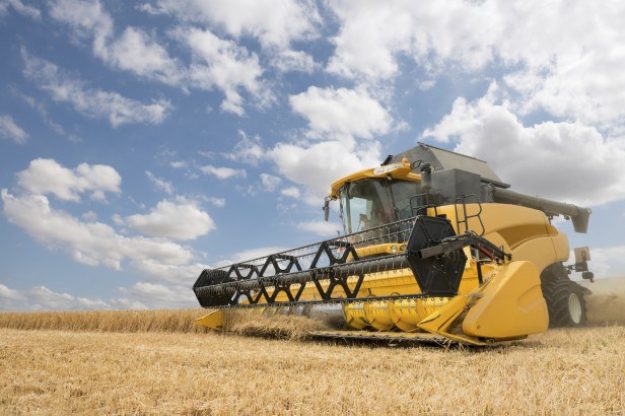The dawn of the smart farmer: Sowing sensors and connecting crops

It’s not just your phone, city and car: Farmers are going smart, too.
The threats of drought, blight and global food shortage have kindled a movement to bring Internet of Things concepts to the farmfront, and the men and women responsible for supplying the world’s sustenance are embracing it with open arms.
It’s been labeled the Internet of Agricultural Things, and experts argue that our ability to cope with future resource needs hinges on our farmers’ ability to adopt it effectively.
“The story is about how we can feed all the people in the world,” said Robert Schmidt, chief information officer for the California Department of Food and Agriculture. “Two to 3 billion more people are going to be on the planet by 2050 — that’s a total of at least 9 billion people.”
Estimates indicate that current production levels cannot sustain a population of this size. To prepare for a global baby boom, farmers will have to grow twice as much food as they currently are, which, Schmidt said, “will only happen through technology.”
The IoAg will function similarly to a smart city, employing connected, sensor technology to optimize the planting, nourishing and harvesting of crops.
Interestingly, many farms are already equipped with an array of tools that will streamline this process. A primary driver in smart technology is data, and that is a frontier that savvy farmers already track meticulously. Although the phrase “big data” is not one often cited in the agricultural community, “they love to talk about [data from] their pumps, meters and gates.”
“Farmers are very interested in leveraging tools they already have to help manage to farm, because it increases production and profit,” Schmidt said. “There’s already IoT – it’s just not called that.”
Data collection will fuel a technique known as “precision farming,” in which farmers are able to calculate the exact amount of resources that should be allocated to each plant and distribute them accordingly. The result are healthier, more robust plants and the conservation of water and fertilizer, which saves money.
The barriers in developing this sort of system are mainly quantitative: California produces 450 types of fruits and vegetables, and determining the ideal amount of nutrients and water used to nourish each is a time-consuming process.
The stakes are high, though – California is currently grappling with one if its worst droughts in its history. To encourage the exercise of precision farming, the state government has launched a series of grants to fund potential solutions. One of these is the University of California Davis Crop Management Grant, which is paying for the development of a mobile app that contains specific data on each crop variety and the precision farming metrics required to optimize results.
And apps are only the beginning. A steady stream of IoAg concepts is pouring out of Silicon Valley startups: smart tractors that can detect how much water a plant needs by analyzing its shade of green, plant tagging that would allow individual fruits and vegetables to be traced from the moment they’re picked to the moment they’re purchased, and several platforms involving drones.
Problems arise when the rural location of many farms becomes tech-inhibitive. Broadband, for example, is a necessary yet scarce asset on farms, mostly because it is difficult to get the right incentives for providers to lay large spans of cable — which can cost $30,000 per mile — to service only a single farm.
Kathy Johnson, executive director of the Office of Broadband Development for Alabama, emphasized that she has been more impressed with the ways farmers use broadband than she has been by applications in tech-heavy industries.
“Farmers cannot survive without the Internet. They need it in tractors, in irrigation systems, for selling crops and buying supplies,” she said. “I’ve met farmers where hardly a moment of the day passes that they don’t need broadband access.”
Another issue is one of communication. Although IoAg startups and the venture capitalists to fund them are in no short supply, there aren’t many channels between either group and the farmers themselves.
“The first question I ask a startup when they pitch their idea is – did you actually talk to the farmers about this?” said Schmidt.
Often, the answer is no.
And this is a problem, since many potential IoAt devices are proving to be prohibitively expensive, and some are posing cybersecurity risks. Given the scope of many farms, which can stretch across hundreds of acres, enhanced software is necessary – yet equipping each sensor system with the equivalent of a smartphone array is not fiscally feasible. Instead, many farmers upload their data to the web through one core hub, which receives transmissions from a series of sensors which are not independently internet-connected.
Encryption has also topped farmers’ IoAg wish list, as there are concerns that pricey tech is vulnerable to theft in expanses of farmland that are often not secured. The tech itself and the data it houses could be valuable to competitors.
The solution to this communication disconnect, said Schmidt, is to rely on the middle slice of the Venn diagram between farmers and techies — people like Schmidt himself, who grew up on a farm but went on to study tech. When this bridge is gapped, though, the potential bounty is untold.
“It will take a couple more years,” Schmidt asid. “But it will be ubiquitous.”


